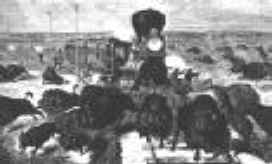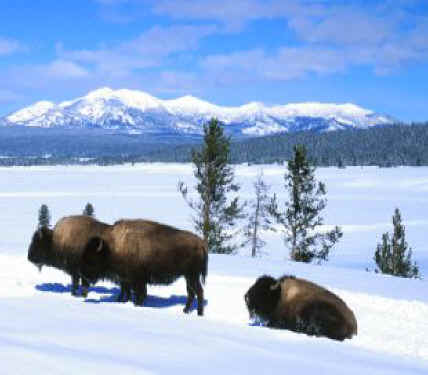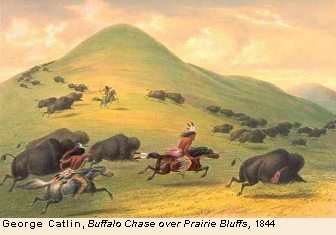![]()



8th American History
Rossville Jr. High
Plains History Project
2004
|
|
|
| The demise of the buffalo was the most tragic event of it's time for sure. As you will read you will learn about the destruction of the Plains Buffalo. The white hunters would just shoot the buffalo just for fun. The railroad was another way for the hunters to get the buffalo. The railroad also helped the traders and hunters ship buffalo hides and meat to factories and family. The Indians used every part ion the body, the don't waste on thing. |
 |
| The amount of bison in North America in the early part of the 19th Century was incredible. They had an estimate range of about 30 to 200 million with 60 million being the best estimate. They were found as far east from the Yukon to Florida. The destruction was the most awful and brutal massacre in it's time. In the beginning of the last decade of the buffalo, the Indians made an effort from wanton destruction. In June 1874, the Senate passed a bill for the protection of the buffalo, but the bill failed to receive the Presidents signature. By the time the bill was not signed by the President to not shoot the buffalo, the southern herd was represented by bones, while the northern herd was in with years of it's extinction. During this enterprise time period the slaughter was world wide. These individuals invariably killed five times as many animals as could be utilized, and cutting from each animal only the parts the shooter wants {the tongue, hind quarters, and the hump}. The slaughter was a sentiment which fostered our desire further to oppress, to bring under subjection and to rob of their birthright. | |
| The building of the Continental Railways through the most populated countries impacted significantly on the buffalo. The Railroad allowed easy access to the buffalo by anyone who wanted to shoot and they did, right from the trains. The settlers that shot the buffalo form trains were backed up by an unlimited supply of new accurate breech-loading rifles and plenty of ammo. A wild rush of white buffalo hunters came to buffalo countries. In June 1872 over 2 million were just killed just for their hides. There is an estimate of 31 million were slaughtered bye 1868 and 1881. The majority of the white buffalo hunters killed for the tongues and hides leaving the carcasses on the Plains to rot. The buffalo tongue was the main meat that the hunters kept. The tongues were purchased at 25 cents each and sold in the markets and sold in the markets farthest east at 50 cents. |
|
| Buffalo Bill Cody had a contract to supply the Kansas and Pacific Railroad with 12 buffalo a day. The government advertised three day buffalo hunts were hunters could hunt an unlimited supply for ten dollars, including a ride and a train and shoots from a window. Carcasses were left in the Prairie sun. Tom Nixon once shot 120 bison in forty minutes. There was a crowd there to witness the kills. He killed over 3500 bison is 35 days. By the time the buffalo country was full of hunters, each hunter putting forth their best efforts to kill more buffalo than the other hunters. | |
| The slaughter which became in 1871 was continued with accelerated vigor and enterprise in 1872, and reached it's highest point in 1873. As the Army progressed westward, the inevitable conflict grew between two parties. The US Army was having quite a time controlling the Indians. Grant vetoed the bill causing the hunters and Sheridan to kill more buffalo. By 1885, less than 500 buffalo survived. Finally, President Cleveland signed the bill to protect the buffalo. "We slaughtered the buffalo in order to starve the Indians off the Plains into submission, there for forcing them into a position in which take what we saw fit to dole them out". | |
| Railroads also made it possible to ship staggering amounts of hides back east to tanners. They would stop the train and just cut the fur off the buffalo that they shot and leave the other part of the body to rot. The prices for the buffalo were good. Fifty cents for a young buffalo and 1.25 for an adult. Most of the British Army goods were made from buffalo leather exclusively for twenty years. At the time, there had been a decimation of Argentine cattle herds, which supplied most of the major leather markets until 1870. In 1870, Josiah Wright Mooar sent some bison hides to his brother in New York, who sold them in a tannery. Satisfied with the out come of a new tanning process, the tannery ordered 2000 more for $3.00 each. Buffalo robes became a fashion statement with most middle and upper income families. They used them for {bedspreads, couch covers, buggy sleigh lap ropes. | |
| In short , the buffalo was the life to the Plains Indians until the white mans goods first eliminated and then replaced the animal. The buffalo meant a lot of thing to all the Native Americans. They were food and clothing, tools and utensils, and most of all a spirit blessing the people with every thing they need to survive. The Indians used every part of the body. They use the dung for fire wood and the rough side of the tongue for a hair brush. The brains were used for tanning agents. The bones were turned into handles for knives. On other hand the white hunters would shoot the buffalo and let them lay. The 200,000 Native Americans Plains Indians were thought to kill 2 million buffalo a year a mere third of the bison's birthrate. A major part of Indian life was oriented around the buffalo herds. They traveled with the buffalo all but the winter months. The bison was the first wild species to be extinct before the advance of civilization. |
|
| The decimation of the Plaines buffalo during the late 1800s brought this magnificent animal to the brink of extinction. In 1872, they made a place where the buffalo could expand their population. When Yellow Stone National Park opened they had twenty-one bison. Today they have 350,00 living there. | |
| Derek Graves
8th American History Rossville Jr. High Plains History Project 2004 |
|
,